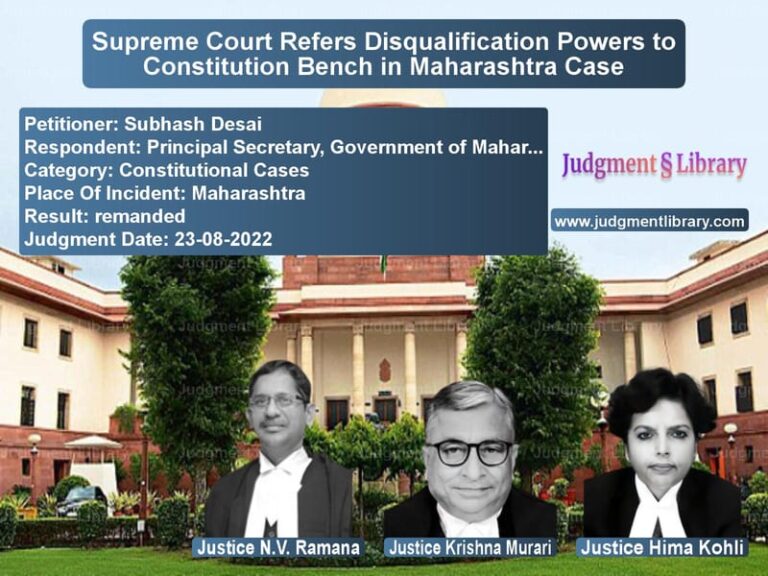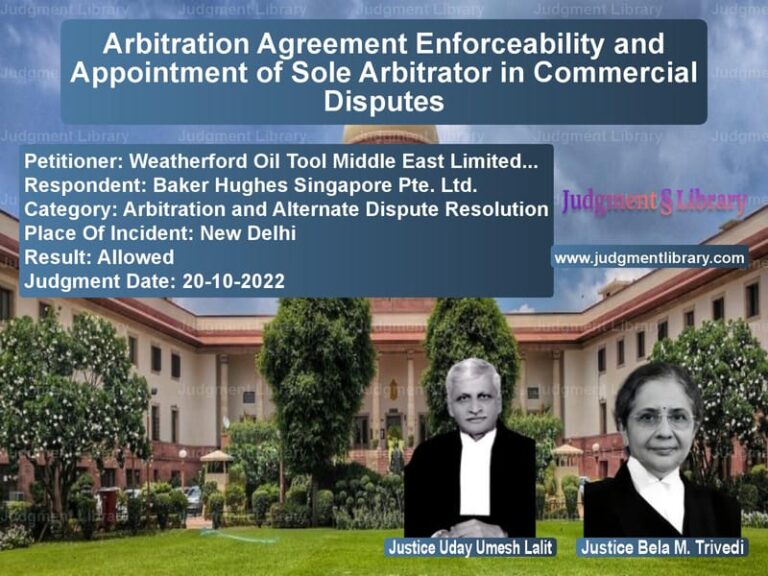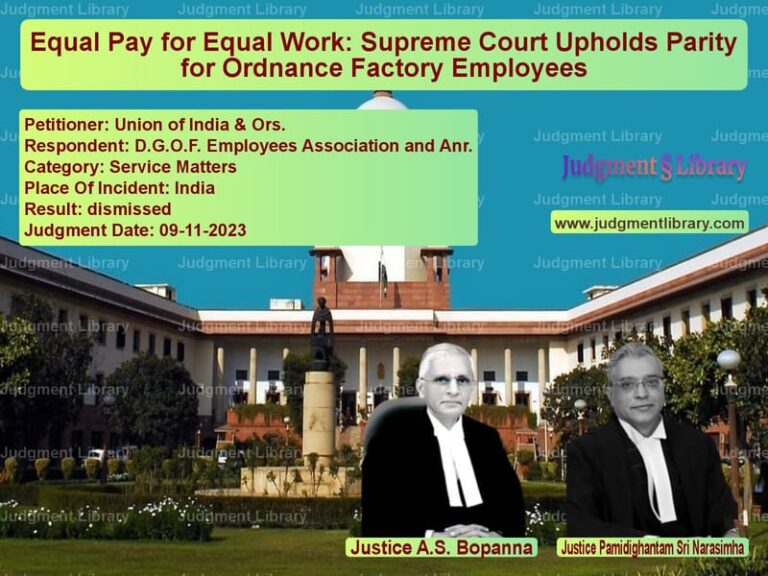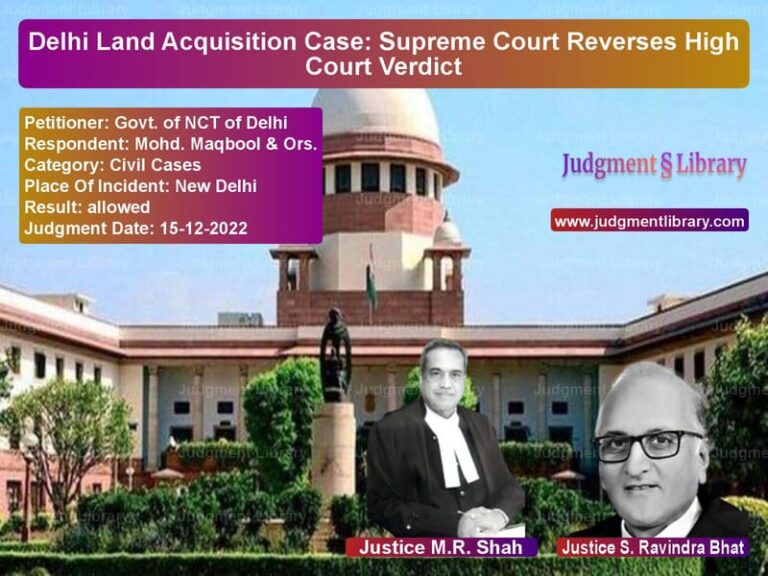Supreme Court Strikes Down High Court Order on Relocation of Tehsil Office in Uttar Pradesh
The Supreme Court of India recently ruled on the case of Aleemuddin v. State of Uttar Pradesh & Others, concerning a controversial decision by the Allahabad High Court to direct the relocation of a tehsil office. The Court found that the High Court had exceeded its jurisdiction by interfering in an administrative matter, setting aside the High Court’s order.
Background of the Case
The case arose from a Public Interest Litigation (PIL) filed in the Allahabad High Court by a petitioner who sought to have the tehsil office for Hasanpur, Amroha district, relocated to Village Karanpur Mafi. The petitioner also requested the government to decide on his representation regarding the same. The High Court accepted the petition and directed the Uttar Pradesh State Government to take necessary steps to construct the new tehsil office at the requested location.
Challenging the High Court Order
- The appellant, Aleemuddin, opposed the High Court’s order, arguing that the PIL was filed for personal gain rather than public interest.
- The appellant claimed that the petitioner before the High Court had vested interests, as the land adjacent to the proposed site for the new tehsil office belonged to his family.
- The appellant further argued that the government had already decided to reconstruct the tehsil building at its original location instead of shifting it to a new site.
State Government’s Response
- The Uttar Pradesh Government confirmed that a proposal for reconstructing the tehsil office at the existing location had been approved.
- The government argued that the High Court had interfered in an executive decision, which was not within its jurisdiction.
- The government asserted that relocating the tehsil office as per the High Court’s order was unnecessary and contrary to administrative policy.
Key Arguments in the Supreme Court
Appellant’s Arguments
- The High Court’s order was based on a PIL that was not genuine and was filed to increase the value of land owned by the petitioner’s family.
- Decisions regarding the location of government offices are purely administrative and should not be interfered with by the courts.
- The government’s decision to rebuild the existing tehsil office instead of shifting it was made in public interest.
Respondent’s Arguments
- The PIL was filed in public interest, considering the need for a new and better-equipped tehsil office.
- Relocating the tehsil office to the new location would serve administrative efficiency and better public service.
- The High Court acted in accordance with its duty to ensure proper governance and infrastructure development.
Supreme Court’s Observations
The Supreme Court examined the facts of the case and concluded that the High Court had no authority to decide the location of the tehsil office. The Court stated:
“Where a tehsil building should be constructed is not a matter for the High Court to determine in the exercise of its writ jurisdiction under Article 226 of the Constitution of India.”
Furthermore, the Court emphasized the importance of distinguishing between genuine and motivated PILs, stating:
“The petition which was filed in the High Court was not a genuine petition in public interest but was intended to subserve the personal interest of the petitioner.”
The Supreme Court noted that High Courts must remain vigilant against the misuse of PILs and should ensure that judicial intervention does not encroach upon executive functions.
Final Judgment
- The Supreme Court set aside the High Court’s order directing the relocation of the tehsil office.
- The Court reaffirmed the government’s authority to make administrative decisions regarding infrastructure development.
- The appeal was allowed, and the matter was left to the discretion of the State Government to decide the location of the tehsil office.
Implications of the Judgment
- Judicial Restraint: The ruling reinforces the principle that courts should not interfere in purely administrative decisions.
- Prevention of PIL Abuse: The decision serves as a warning against the misuse of Public Interest Litigation for personal or financial gain.
- Administrative Authority Upheld: The ruling confirms that infrastructure and public office planning fall within the purview of the government, not the judiciary.
Conclusion
This judgment is a crucial precedent on the role of courts in administrative decision-making. It upholds the separation of powers between the judiciary and the executive, ensuring that policy decisions remain within the government’s domain. It also strengthens safeguards against the misuse of PILs for personal interests.
Petitioner Name: Aleemuddin.Respondent Name: State of Uttar Pradesh & Others.Judgment By: Justice D.Y. Chandrachud, Justice M.R. Shah.Place Of Incident: Amroha, Uttar Pradesh.Judgment Date: 30-11-2018.
Don’t miss out on the full details! Download the complete judgment in PDF format below and gain valuable insights instantly!
Download Judgment: Aleemuddin vs State of Uttar Prade Supreme Court of India Judgment Dated 30-11-2018.pdf
Direct Downlaod Judgment: Direct downlaod this Judgment
See all petitions in Public Interest Litigation
See all petitions in Separation of Powers
See all petitions in Judgment by Dhananjaya Y Chandrachud
See all petitions in Judgment by Mukeshkumar Rasikbhai Shah
See all petitions in allowed
See all petitions in Quashed
See all petitions in supreme court of India judgments November 2018
See all petitions in 2018 judgments
See all posts in Constitutional Cases Category
See all allowed petitions in Constitutional Cases Category
See all Dismissed petitions in Constitutional Cases Category
See all partially allowed petitions in Constitutional Cases Category







